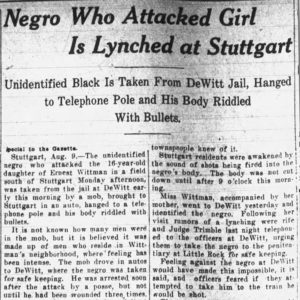calsfoundation@cals.org
Stuttgart Lynching of 1916
An unidentified African-American man was taken from the jail in DeWitt (Arkansas County) and lynched in Stuttgart (Arkansas County) on August 9, 1916, for having allegedly attacked a sixteen-year-old white girl. This was the first of two lynchings to occur in Arkansas County that year—on October 8, 1916, Frank Dodd was also taken from the jail at DeWitt, though he was lynched in town.
According to the Arkansas Gazette, on Monday, August 7, the unidentified man—described only as “about 25 years old and unknown here”—attacked the sixteen-year-old daughter of farmer Ernest Wittman in a field south of Stuttgart. The narrative is vague, indicating that the unknown man was arrested after having been attacked and wounded by a posse; he was subsequently taken to DeWitt and kept in jail there. Wittman and her mother traveled to DeWitt on August 9, and the young woman apparently identified him as her attacker.
The narrative offered by the Arkansas Democrat is a little more coherent. According to its account, the unknown man was about twenty years old, was from Osceola (Mississippi County), and had “been loafing about Stuttgart for several days,” making no attempt to get work and thus leading locals to believe “that he was a tramp.” This man approached the young woman while she was in a field near her home. He began asking her questions and then attacked her, but she was able to break loose and run home. A posse captured the man and placed him in the jail at Stuttgart. However, fearing a lynching, authorities transported the man to DeWitt, first traveling in the direction of Little Rock (Pulaski County) in order to deceive would-be pursuers about their intended destination. According to the Pine Bluff Daily Graphic, the deception apparently worked until authorities then had the victim come to DeWitt in order to identify her assailant.
While the man was in police custody, according to the Arkansas Gazette, a Judge Trimble (possibly Thomas C. Trimble Sr., who was appointed to the Seventeenth Circuit in 1914) telephoned authorities in DeWitt and urged them to transport their prisoner to the state penitentiary in Little Rock in order to prevent a lynching. However, local officers reportedly feared that he would be killed in transit. That evening, members of the mob drove to DeWitt and removed the prisoner from the jail “so quietly that none of the townspeople knew of it.” They then transported him to Stuttgart, where they hanged him from a telephone pole and fired into his body, waking the townspeople. The corpse was cut down at 9:00 a.m. The Democrat offered some more-specific details, numbering the mob at about twenty people and noting that the mob transported the man to “the negro section” of Stuttgart, hanging him from a tree in the center of the section.
Representatives of the mob wrote a letter to the Stuttgart Free Press newspaper, which was reprinted in the Arkansas Democrat, defending their actions and objecting to “false stories which have been circulating concerning the lynching bee.” According to the letter, the condemned man requested that he not be tortured or burned and “made a full, free and voluntary confession of his guilt before being executed.” The letter also insists that the man was “hanged in as humane a manner as possible.”
For additional information:
“Assailant of Girl Lynched by Mob of 20.” Arkansas Democrat, August 9, 1916, p. 1.
“Kill Girl’s Assailant.” Topeka State Journal, August 9, 1916, p. 1.
“Miss Whitman’s [sic] Assailant Pays Usual Penalty.” Pine Bluff Daily Graphic, August 10, 1916, p. 1.
“Mob Victim Was Extended Every Earned Courtesy.” Arkansas Democrat, August 14, 1916, p. 1.
“Negro Who Attacked Girl Is Lynched at Stuttgart.” Arkansas Gazette, August 10, 1916, p. 12.
Staff of the CALS Encyclopedia of Arkansas
 Civil Rights and Social Change
Civil Rights and Social Change Early Twentieth Century, 1901 through 1940
Early Twentieth Century, 1901 through 1940 Stuttgart Lynching Article
Stuttgart Lynching Article 




Comments
No comments on this entry yet.